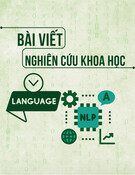
T
ẠP CHÍ KHOA HỌC
TRƯ
ỜNG ĐẠI HỌC SƯ PHẠM TP HỒ CHÍ MINH
Tập 21, Số 6 (2024): 1039-1051
HO CHI MINH CITY UNIVERSITY OF EDUCATION
JOURNAL OF SCIENCE
Vol. 21, No. 6 (2024): 1039-1051
ISSN:
2734-9918
Websit
e: https://journal.hcmue.edu.vn https://doi.org/10.54607/hcmue.js.21.6.4322(2024)
1039
Research Article1
THE EFFICACY OF INTERACTIVE VIDEOS
IN DEVELOPING LISTENING SUB-SKILLS:
A STUDY OF VIETNAMESE HIGH SCHOOL STUDENTS
Nguyen Ngo Tan Dat*, Bui Tri Vu Nam
Ho Chi Minh City University of Education, Vietnam
*Corresponding author: Nguyen Ngo Tan Dat – Email: 4701701076@student.hcmue.edu.vn
Received: June 07, 2024; Revised: June 18, 2024; Accepted: June 22, 2024
ABSTRACT
Interactive videos have demonstrated significant potential in L2 listening instruction
compared to conventional linear videos. This study investigates the efficacy of interactive videos in
developing high school students' listening sub-skills. A quasi-experimental design was employed with
67 10th-grade English majors at a Vietnamese high school over five weeks. Participants were
assigned to experimental (n=34) and control (n=33) groups based on pre-test scores. T-test results
revealed that the experimental group significantly improved in listening for specifics and inferential
listening, while the control group showed no significant improvements in these sub-skills. However,
no statistically significant differences were observed in gist listening proficiency for either group.
These findings suggest that interactive videos positively influence learners' ability to listen for
specifics and make inferences, but not their gist-listening skills. Consequently, L2 teachers are
advised to consider integrating interactive videos strategically within listening lesson procedures.
Keywords: interactive videos; inferential listening; listening sub-skills; listening for gist;
listening for specifics
1. Introduction
1.1. Research problem and purpose
Classified as one of the two receptive skills alongside reading, listening skill plays a
crucial role in L2 acquisition thanks to the comprehensible input it equips the learners with
(Feyten, 1991). However, this skill is believed to pose the greatest challenge for both
teachers and learners during the process of teaching and learning foreign languages. The fact
that listening often renders learners stressed and anxious is attributable to the demand for
them to process the input immediately (Arnold, 2000). On the other hand, there is a paucity
of in-depth studies into this field, hence its alternative name- “Cinderella” (Nunan, 2002).
Cite this article as: Nguyen Ngo Tan Dat, & Bui Tri Vu Nam (2024). The efficacy of interactive videos in
developing listening sub-skills: A study of Vietnamese high school students. Ho Chi Minh City University of
Education Journal of Science, 21(6), 1039-1051.

HCMUE Journal of Science
Nguyen Ngo Tan Dat et al.
1040
This is also reflected in the context of Vietnamese L2 instruction in that more investments
are needed for listening skill research (Miller, 2014). According to Nguyen and Hoang
(2023), one of the prominent causes of learners’ limited competence in listening skills lies
in their disinterest in studying this skill, inevitably resulting in teachers’ reduced motivation
to teach it.
In an attempt to ameliorate the practice of listening skill education, there has been an
increasing involvement of videos as an effective teaching strategy to supplant audio-only
materials (Lesnov, 2022). Brame (2016) also appreciates the role of videos in alleviating
learners’ anxiety levels, yet “the use of video is only beginning to meet the needs of today’s
and tomorrow’s learners” (Mendoza et al., 2015, p. 81). A remarkable breakthrough of
ordinary linear videos is enhanced videos with interactive elements, particularly embedded
questions, which encourage better learner-content interaction (Zhang et al., 2006). When it
comes to L2 teaching and learning contexts, interactive videos have been empirically said to
yield a positive effect on learners’ grammar competence (Taslibeyaz, 2020) and writing
skills (Zou & Xie, 2019). The teaching of listening skills is an auspicious ground for applying
these videos as indicated by He (2022) because the majority of participants in her study
express their preferences for interactive videos. The rationale behind their marked preference
is reported to be the reduction in distracting factors that normally goes hand in hand with
increased attention span during test time. Nguyen (2024) found that interactive videos as
innovative teaching media almost led to significant improvements in learners’ listening skills
and their overall acceptance of this method as a form of listening practice rather than
summative assessment. According to Xu (2017), improved listening competence can stem
from learners’ dynamic adjustments of their learning strategies (i.e. metacognitive strategies)
while taking listening tests based on interactive videos.
Regarding teaching listening practices from the perspective of Vietnam, the General
Education Curriculum for English (Vietnam Ministry of Education and Training – MOET),
2018) explicitly requires learners to achieve two main learning outcomes for English
listening skills: listening for main ideas and listening for specifics. Moreover, there is a close
alignment between the aforementioned outcomes and the required exit proficiency of level
3 of the 6-level VSTEP (Vietnamese Standardized Tests of English Proficiency) for listening
skills, equivalent to the B1 level of CEFR (Common European Framework of Reference for
Languages) (Phuong, 2020). In this study, the authors have difficulties accessing random
samples representing the population of high school students in general, which rationalizes
the addition of the “inferential listening” category as an extra outcome for English majors, a
prominent characteristic of competent listeners at level 4-5 VSTEP (or B2-C1 CEFR)
according to the Decision 729/QD-BGDDT dated 11/3/2015 by MOET. This study aims to
evaluate the extent of effectiveness of listening lessons integrated with interactive videos for

HCMUE Journal of Science
Vol. 21, No. 6 (2024): 1039-1051
1041
improving each separate sub-skill, a rarely investigated topic in previous studies, and suggest
further innovations for this method of teaching listening.
This study addresses the following research question: What effects does the use of
interactive videos in teaching listening skills have on high school students’ listening sub-
skills, specifically gist listening, listening for specifics, and inferential listening? The
research hypothesis posits that students will demonstrate significant improvements in these
listening sub-skills following the intervention.
1.2. An overview of interactive videos in comparison with linear videos
Figure 1. Several outstanding features of interactive videos
The superiority of interactive videos compared to conventional linear ones is
illustrated in Figure 1. Sweller (1994) reports that every individual’s working memory has a
limited capacity to process and store information, or the so-called “cognitive load.”
Cognitive overload occurs as a consequence of processing an amount of input exceeding the
allowed cognitive capacity. This is believed to be a prevalent problem for test-takers during
the while-listening performance (WLP) tests, as they are supposed to watch the videos
attentively, jot what they hear down, and determine the optimal time to answer each test item
concurrently (Suvorov & He, 2022). The separation of comprehension questions from videos
in paper-based listening tests induces a split-attention effect and an increased cognitive load
ensues (Sweller et al., 2011, as cited in Suvorov & Li, 2023). Therefore, interactive videos
outweigh linear ones in that pop-up test items enable learners to watch the video and respond
to each question at two discrete time points, which bear a close resemblance to post-listening
performance (PLP) tests (Ayadoust, 2012).
In terms of the segmentation principle, Mayer (2014) says that it aims to split the long
and complicated texts into shorter comprehensible chunks and facilitate learners’
acquisition. Adam (2022) asserts that the application of this principle into interactive video
design makes them an effective approach to free up “more space” in learners’ working
memory, thereby reducing cognitive load. Another feature of interactive videos based on the
signaling principle is the timeline with stretching color and the dots indicating the locations

HCMUE Journal of Science
Nguyen Ngo Tan Dat et al.
1042
of the questions, which is also a contributory factor to an overall decrease in learners’
cognitive load (Loman & Mayer, 1983). Suvorov and Li (2023) report that the participants
in their study reaped some benefits of better preparations for the upcoming questions from
these dots as a result of their feeling of being guided throughout watching time, and enhanced
ability to extract keywords from the input.
Rice et al. (2019) argue that embedding questions throughout the videos is more
effective than post-video mass questioning due to decreased cognitive load and increased
attention span. The inclusion of questions within videos serves to bridge new information
with existing knowledge (Mayer, 1975, as cited in Chang, 2021). These questions,
strategically placed within the videos, highlight important points identified by the instructor
that facilitate learners’ comprehension and retention. Furthermore, these questions can
function as a cognitive guide for viewers to recognize the connections between key concepts
and understand the overall structure of the presented materials (Chang, 2021).
According to Chang (2021), immediate feedback promotes learners’ active processing,
which is conducive to an increased germane load by instantly rectifying their
misunderstandings of the stimuli and reconstructing more accurate representations in mind.
Lee et al. (2012) state that despite better records of performance for learners receiving instant
feedback, their stress levels are not even kept in moderation but heightened instead; however,
this kind of stress is termed “eustress-like anxiety,” which results in the positive impact of
increased attention afterward. Similar results are also reported in Suvorov and Li (2023) that
those expressing their favor for instant feedback appreciate its motivating effect to be more
cautious in responding to the subsequent questions, though learners hold mixed perceptions
regarding this aspect.
1.3. Listening sub-skills
Several scholars have categorized listening into distinct sub-skills which are essential
for learning progress. Moran (2005) identifies these as grasping the main idea, drawing
conclusions based on background knowledge, and comprehending contracted consonants.
Similarly, Nunan (2002) breaks down listening into three categories: listening for the main
idea, listening for details, and listening for making inferences. Field (2009) specifies that
learners might listen for a gist, a single piece of information, or in-depth understanding
depending on the task and input provided. On the other hand, Peterson (2001) emphasizes
the importance of combining global (gist-oriented) and selective (detail-oriented) listening
exercises in L2 classrooms. According to Buck (2001), understanding the gist of a text
involves linking idea units together for interpretation. In favor of this, Siegel (2018) states
that neither a piece of information nor an idea unit alone serves the same interpretive
function. However, Alderson (2000) questions the classifiability and measurability of these
comprehension sub-skills, while Buck (2001) defends their collective existence as
significant for understanding listening comprehension.

HCMUE Journal of Science
Vol. 21, No. 6 (2024): 1039-1051
1043
1.4. Listening strategies
As defined by Rost (2001), “listening strategies are conscious plans to deal with
incoming speech, particularly when the listener knows that he or she must compensate for
incomplete input or partial understanding” (p. 10). Buck (2001) declares that there are two
categories of listening strategies, namely metacognitive strategies and cognitive strategies.
Meanwhile, many other studies add another group termed “socio-affective strategies”
(Graham et al., 2011; Peterson, 2001), but this pales into insignificance compared to the
others in this particular study due to limited peer discussions during the lesson time. Yang
(2009) asserts that the difference between successful listeners and unsuccessful ones lies in
their utilization of metacognitive strategies, advocating for the teaching of metacognitive
roles in L2 listening to enhance listeners’ effectiveness in approaching listening tasks.
Wenden (1998) suggests that listeners equipped with metacognitive strategies outperform
those ignorant of metacognition’s role in L2 learning, partially attributed to the former
group’s clearer considerations about their failed solutions during an activity.
Field (2009) acknowledges loose differentiation between metacognitive and cognitive
strategies because it depends on whether the learners think about what courses of action they
will take or not. Cognitive strategies are described as “operat(ing) directly on incoming
information, manipulating it in ways that enhance learning” (O’Malley & C’hamot, 1990, as
cited in Field, 2009, p. 294). Specifically, these encompass listening for gist and details,
making inferences and predictions, visualization, note-taking, and summarizing (Graham et
al., 2011). Metacognitive strategies, on the other hand, involve learners’ mental processes,
whether deliberate or automatic, in directing cognitive strategies (Richards, 2009). Graham
et al. (2011) pinpoint the components of this type of strategy which are directed attention,
selective attention, planning, monitoring, and evaluation.
Planning strategies entail establishing learning goals and seeking ways to accomplish
those objectives, such as main ideas previewing, language rehearsal, and determining crucial
parts in the text to focus on (Goh, 1997, 1998, as cited in Richards, 2009). Moreover, the
differences in learning effectiveness between instant feedback and delayed feedback lie in
the learners’ monitoring and evaluating strategies respectively. In the same studies, Goh
defines monitoring strategies as tactics for tracking learning progress while completing a
listening task, enabling the learners to detect repeated mistakes and underlying causes of
their listening struggles. Evaluating strategies, on the contrary, refers to checking “the
appropriateness and the accuracy of what has been understood” (Goh, 1997, 1998 as cited
in Richards, 2009, p. 12), which necessarily means that evaluation only happens when WLP
is completed. As argued by this author, post-listening evaluation enables the listeners to self-
assess their holistic comprehension of the text. Also, according to Nguyen (2018), directed
attention and selective attention are used to grasp the gist and specifics in their respective
order. Regarding this, Nguyen Dinh (2023) and Rost (2011) define directed attention as a




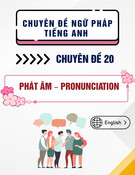



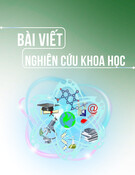


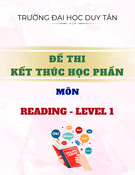
![Đề cương môn Tiếng Anh 1 [Chuẩn Nhất/Mới Nhất]](https://cdn.tailieu.vn/images/document/thumbnail/2025/20251130/cubabep141@gmail.com/135x160/51711764555685.jpg)






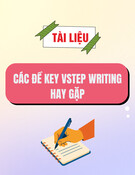

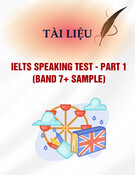

![Mẫu thư Tiếng Anh: Tài liệu [Mô tả chi tiết hơn về loại tài liệu hoặc mục đích sử dụng]](https://cdn.tailieu.vn/images/document/thumbnail/2025/20250814/vinhsannguyenphuc@gmail.com/135x160/71321755225259.jpg)
